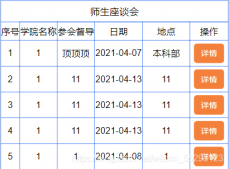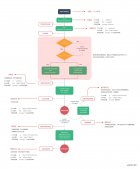一、this.$router.push()
1、vue
|
1
2
3
4
5
|
<template> <div id='test'> <button @click='goTo()'>点击跳转4</button> </div></template> |
2、script
|
1
2
3
4
5
6
7
8
9
10
11
12
13
14
15
16
17
18
19
20
21
22
23
24
25
26
27
|
//跳转前页面传参数:goTo(item) { //storageData中数据用于跳转到下一个页面之后,进行返回时能够返回到跳转之前的页面 let storageData = { searchWords: this.keyWord, pageSize: this.paging.pageSize, pageNo: this.paging.currentPage }; //data中数据用于将本页面中数据通过跳转功能将其应用到下一个页面,与父子组件传值同理 let data = { type: item.srcType, tableName: item.tableName, name: item.datasourceName, tableId: item.tableId, id: item.datasourceId, }; //将下一个页面中将会用到的数据全部push到$router中 this.$router.push({ //name表示跳转之后的资源前端访问路径,query用于存储待使用数据,其中page是本页面name, name: 'onlineSearch', query: {targetData: data ,storageData, page:'search', isBackSelect: true, goBackName:'dataSearch' } }) } |
3、跳转后的页面中获取上个页面的参数值
|
1
2
3
4
5
|
//跳转后页面获取参数:mounted() { //查看是否已经参数是否传至跳转之后的页面,若传入,则根据需求进行调用 console.log(this.$route.query.targetData;)} |
4、从跳转后的页面返回跳转前页面
|
1
2
3
4
5
6
7
8
9
10
11
12
|
//将返回函数写到methods中goBackSheet() { if(this.$route.query.goBackName === 'dataSearch'){ this.$router.push({ name: this.pageName, query: { storageData: this.$route.query.storageData, isBackSelect: true, } }); }} |
二、router-link跳转
1、 通过 to 属性指定目标地址
query相当于get请求,页面跳转的时候,可以在地址栏看到请求参数;
query 刷新 不会 丢失 query里面的数据;
query要用path来引入。
params相当于post请求,参数不会再地址栏中显示;
params 刷新 会 丢失 params里面的数据;
params要用name来引入。
|
1
2
3
4
5
|
<!-- 命名的路由 --><router-link :to="{ name: 'user', params: { userId: 123 }}" @click.native='goTo'>User</router-link><!-- 带查询参数,下面的结果为 /register?plan=private --><router-link :to="{ path: 'register', query: { plan: 'private' }}" @click.native='goTo'>Register</router-link> |
2、跳转后页面
|
1
2
3
4
5
6
|
watch:{ $route(to,from){ //刷新页面 this.$router.go(1); } } |
以上就是vue 页面跳转的实现方式的详细内容,更多关于vue 页面跳转的资料请关注服务器之家其它相关文章!
原文链接:https://www.cnblogs.com/qing0228/p/13933066.html

















